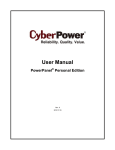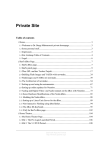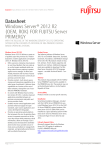Download Your PRIMERGY MX130 S1
Transcript
Operating Manual Server PRIMERGY MX130 S1 Congratulations! You have decided to buy an innovative Fujitsu product. The latest information about our products, useful tips, updates etc. is available from our website: http://ts.fujitsu.com For automatic driver updates, please go to: http://support.ts.fujitsu.com/com/support/index.html Should you have any technical questions, please contact: ● our Hotline/Service Desk (see Service Desk list or visit: http://ts.fujitsu.com/support/servicedesk.html) ● your sales partner ● your sales office We hope you really enjoy using your new Fujitsu system. Copyright Fujitsu Technology Solutions 2011/11 Published by Fujitsu Technology Solutions GmbH Mies-van-der-Rohe-Straße 8 80807 München, Germany Contact http://ts.fujisu.com/support All rights reserved, including intellectual property rights. Technical data is subject to changes; deliverability is dependent on availability. No guarantee of completeness, topicality or correctness of the data and illustrations is given and any liability associated therewith is excluded. Brand names may be protected trademarks of the respective manufacturer and/or protected by copyright. Their use by third parties for their own purposes could represent a violation of the rights of the owner. For more information, see "http://ts.fujitsu.com/terms_of_use.html" Order No. Fujitsu Technology Solutions: A26361-K1070-Z320-1-7619, Edition 2 PRIMERGY MX130 S1 Operating Manual Your PRIMERGY MX130 S1... 1 Important notes 5 Preparing for use 13 Operation 27 Troubleshooting and tips 35 System expansions 39 Technical data 73 Index 75 PRIMERGY is a registered trademark of Fujitsu Technology Solutions GmbH. Microsoft, Windows, Windows Server and Hyper V are trademarks or registered trademarks of the Microsoft Corporation in the USA and other countries. PS/2 is a registered trademark of International Business Machines, Inc. Kensington Lock and MicroSaver are registered trademarks of ACCO World Corporation. All other trademarks referenced are trademarks or registered trademarks of their respective owners, whose protected rights are acknowledged. Copyright © Fujitsu Technology Solutions GmbH 2010 All rights, including rights of translation, reproduction by printing, copying or similar methods, in part or in whole, are reserved. Offenders will be liable for damages. All rights, including rights created by patent grant or registration of a utility model or design, are reserved. Delivery subject to availability. Right of technical modification reserved. Contents Your PRIMERGY MX130 S1... ............................................................................................................ 1 Target Group for this Operating Manual ............................................................................................... 1 Notational conventions ......................................................................................................................... 2 Information sources .............................................................................................................................. 3 Important notes .................................................................................................................................. 5 Safety notes .......................................................................................................................................... 5 Transporting the device ........................................................................................................................ 5 Cleaning the device .............................................................................................................................. 5 Saving energy, disposal and recycling ................................................................................................. 6 CE marking ........................................................................................................................................... 6 FCC Class A Compliance Statement ................................................................................................... 7 FCC Class B Compliance Statement ................................................................................................... 8 Energy Star ........................................................................................................................................... 9 Operating System Microsoft Windows Server 2008 R2 ............................................................. 10 LINUX Operating Systems ......................................................................................................... 11 Preparing for use .............................................................................................................................. 13 Unpacking and checking the delivery ................................................................................................. 13 Steps for initial setup .......................................................................................................................... 13 Setting up the device .......................................................................................................................... 14 Connecting external devices .............................................................................................................. 17 Ports on the device ..................................................................................................................... 18 Connecting a monitor ................................................................................................................. 18 Connecting the mouse ............................................................................................................... 18 Connecting a keyboard............................................................................................................... 19 Connecting external devices to the serial port or a USB port ..................................................... 19 Connecting the device to the mains supply ........................................................................................ 20 Indicators on the device...................................................................................................................... 21 Switching on the monitor and device .................................................................................................. 22 Installing the software ......................................................................................................................... 25 Operation ........................................................................................................................................... 27 Switching the device on ...................................................................................................................... 27 Switching off the device ...................................................................................................................... 27 Keyboard ............................................................................................................................................ 28 Important keys and key combinations ........................................................................................ 28 Configure device................................................................................................................................. 30 Configuration with ServerView Suite .......................................................................................... 30 Configuration without ServerView Suite ..................................................................................... 30 Configuring the SATA RAID controller ....................................................................................... 30 Settings in BIOS Setup ....................................................................................................................... 31 Property and data protection .............................................................................................................. 31 Anti-theft protection and lead-sealing ......................................................................................... 32 BIOS setup security functions .................................................................................................... 33 Troubleshooting and tips................................................................................................................. 35 Help if problems occur ................................................................................................................ 35 Installing new software ....................................................................................................................... 35 Power-on indicator remains unlit after you have switched on your device ......................................... 36 The device cannot be switched off with the ON/OFF switch .............................................................. 36 The screen stays blank....................................................................................................................... 37 No mouse pointer displayed on the screen ........................................................................................ 38 Fujitsu Technology Solutions Contents Time and/or date is not correct ........................................................................................................... 38 Error messages on the screen ............................................................................................................ 38 System expansions ........................................................................................................................... 39 Information about boards ............................................................................................................ 39 Opening the casing ............................................................................................................................. 40 Closing the casing ............................................................................................................................... 41 Installing and removing the cross-piece .............................................................................................. 42 Removing the cross-piece .......................................................................................................... 42 Installing the cross-piece ............................................................................................................ 42 Replacing the rear panel ..................................................................................................................... 43 Installing and removing a board .......................................................................................................... 45 Installing board in low-profile slot ................................................................................................ 45 Removing board from low-profile slot ......................................................................................... 46 Installing and removing an additional optional port ............................................................................. 47 Installing an optional port ............................................................................................................ 47 Removing an optional port .......................................................................................................... 48 Overview of the Drive Bays in Your Device ........................................................................................ 49 Preparation and follow-up work for installing and removing the drive ................................................. 51 Removing and installing the EMC cover ..................................................................................... 51 Folding the drive cage up and down ........................................................................................... 53 Installing and removing two 2½ inch hard disk drives in additional 3½ inch installation frames ................................................................................................................................. 55 Installing and removing drives in a 3½ inch bay below the power supply ........................................... 58 Installing and removing hard disk drives in a 3½ inch bay below the power supply ................... 58 Installing and removing drives in a 3½ inch bay at the front of the device .......................................... 61 Installing and removing a 3½ inch hard disk drive in a 3½ inch bay at the front of the device ... 61 Installing and removing two 2½ inch hard disk drives in a 3½ inch bay at the front of the device.................................................................................................................................. 63 Installing and removing drives in a 5¼ inch bay at the front of the device using EasyChange .......... 64 Installing and removing an accessible 5¼ inch drive .................................................................. 64 Installing and removing two 2½ inch hard disk drives in a 5¼ inch installation frame capable of accommodating a hard disk in a 5¼ inch bay ................................................... 66 Installing and removing two 2½ inch hard disk drives and an optical drive (slim-line) in a slim-line 5¼ inch installation frame capable of accommodating a hard disk in a 5¼ inch bay............................................................................................................................... 68 Extensions to the mainboard............................................................................................................... 70 Upgrading main memory ............................................................................................................. 70 Replacing the processor ............................................................................................................. 70 Replacing lithium battery............................................................................................................. 71 Technical data ................................................................................................................................... 73 Index ................................................................................................................................................... 75 Fujitsu Technology Solutions Your PRIMERGY MX130 S1... ... is an AMD-based server for workgroups and small networks. The server is suitable for file server services and as an application, information or Internet server. The PRIMERGY MX130 S1 offers a high level of data security and availability thanks to sophisticated hardware and software components. It is available in a variety of configurations which differ in terms of the hardware and software used. You can install accessible drives (for example, a DVD drive) and other modules. Using the supplied "Drivers & Utilities" DVD or the "ServerView Suite" DVD, you can configure and administer your PRIMERGY server quickly and to suit your specific requirements. User-friendly menus are provided for installing the server operating systems. The device is service-friendly and has a modular design which means it can be maintained quickly and easily. Security functions in the BIOS Setup and on the mainboard protect the data on the server from being manipulated. Thanks to the supported RAID levels, the hard disk drive controllers offer error tolerance through data redundancy for users requiring complete protection for their valuable data. This manual tells you how to start up your device and how to operate it for daily use. This manual applies to all configuration levels. Depending on the chosen configuration level, some of the hardware components described may not be available on your PC. Please also read the notes about your operating system. In standard configurations, the PRIMERGY MX130 S1 has a power management system which, when in power-saving mode, reduces the power consumption to less than 65 W. With this level of power management, the server fulfils the conditions of the U.S. Environmental Protection Agency (EPA) (see Section "Energy Star"). Target Group for this Operating Manual The operating manual is intended for persons who are responsible for installing the hardware and operating the device in the proper manner. The operating manual describes how to start up and operate the PRIMERGY MX130 S1. To understand the manual, you require knowledge of hardware and data transmission as well as a basic knowledge of the operating system used. A knowledge of English is also required. Fujitsu Technology Solutions 1 Introduction Notational conventions The following symbols are used in this manual: ! i indicates information which is important for your health or for preventing physical damage. indicates important information which is required to use the system properly. ► Text which follows this symbol describes activities that must be performed in the order shown. This font indicates programme names, commands, or menu items. "Quotation marks" indicate names of chapters, data carriers, and terms that are being emphasised. 2 Fujitsu Technology Solutions Your PRIMERGY MX130 S1... Information sources i The information sources are also available to download free-of-charge from our website: at http://ts.fujitsu.com/support, you will find an overview page with the online documentation available on the Internet. You access the documentation for the PRIMERGY server by selecting the product group "industry standard servers". Information sources for the PRIMERGY Server: Depending on the system shipped, the manuals in PDF format listed below are stored on the "Drivers & Utilities" DVD and / or on the "ServerView" Suite DVD. Type of information Where? "Getting Started Hardware" Poster Printed ● "ServerView Suite" DVD Information on ServerView Suite ● "ServerBooks" DVD ● "ServerSupport" DVDs Operating Manual Mainboard D2974 PDF file "Safety/Regulations" manual Printed "Warranty" manual PDF file "Returning used devices" manual PDF file "Service Desk" supplement Printed Further information sources: ● Monitor operating manual ● Documentation for your operating system ● Information files for your operating system (e.g. *.PDF, *.HTML, *.DOC, *.CHM, *.TXT, *.HLP) A26361-K1070-Z320-1-7619, edition 1 1 3 Introduction 4 Fujitsu Technology Solutions Important notes In this chapter you will find information regarding safety which it is essential to take note of when working with your device. Safety notes ! Pay attention to the information provided in the "Safety" manual and in the following safety notes. During installation and before operating the device, please observe the instructions on environmental conditions in the "Technical data" chapter as well as the instructions in the "Preparing for use" chapter. You may only operate the device, if the rated voltage for the device is set to the local mains voltage. Check the rated voltage set for this device (see the "Preparing for use" chapter). The ON/OFF switch does not disconnect the device from the mains voltage. To completely disconnect the mains voltage, remove the power plug from the grounded mains outlet. Replace the lithium battery on the mainboard in accordance with the instructions in the "Extensions to the mainboard" - " Replacing lithium battery" chapter. Caution, components in the system can get very hot. Transporting the device ! Transport all parts separately in their original packaging or in a packaging which protects them from knocks and jolts, to the new site. Do not unpack them until all transportation manoeuvres are completed. Cleaning the device ! Turn off all power and equipment switches and remove the power plug from the mains supply. Do not clean any interior parts yourself, leave this job to a service technician. Do not use any cleaning agents that contain abrasives or may corrode plastic. Ensure that no liquid enters the system. Wipe the casing with a dry cloth. If particularly dirty, use a cloth that has been moistened in mild domestic detergent and then carefully wrung out. Use disinfectant wipes to clean the keyboard and the mouse. Fujitsu Technology Solutions 5 Important notes Saving energy, disposal and recycling There is information on these issues on the "Drivers & Utilities" CD, in the ServerView Suite documentation or on the Internet at http://ts.fujitsu.com. CE marking The shipped version of this device complies with the requirements of the EC Guidelines 2004/108/EC "Electromagnetic compatibility" and 2006/95/EC "Low voltage directive". CE marking for devices with radio component This equipment complies with the requirements of Directive 1999/5/EC of the European Parliament and Commission from 9 March, 1999 governing Radio and Telecommunications Equipment and mutual recognition of conformity. This equipment can be used in the following countries: Belgium Finland Ireland Liechtenstein Netherlands Portugal Slovenia Hungary Denmark France Iceland Lithuania Norway Sweden Spain Cyprus Germany Greece Italy Luxemburg Austria Switzerland Bulgaria Czech Republic Estonia UK Latvia Malta Poland Slovakia Rumania Contact the corresponding government office of the respective country for current information on possible operating restrictions. If your country is not included in the list, then please contact the corresponding supervisory authority as to whether the use of this product is permitted in your country. 6 Fujitsu Technology Solutions Important notes FCC Class A Compliance Statement If there is an FCC statement on the device, then: The following statement applies to the products covered in this manual, unless otherwise specified herein. The statement for other products will appear in the accompanying documentation. NOTE: This equipment has been tested and found to comply with the limits for a "Class A" digital device, pursuant to Part 15 of the FCC rules and meets all requirements of the Canadian InterferenceCausing Equipment Standard ICES-003 for digital apparatus. These limits are designed to provide reasonable protection against harmful interference in a residential installation. This equipment generates, uses and can radiate radio frequency energy and, if not installed and used in strict accordance with the instructions, may cause harmful interference to radio communications. However, there is no warranty that interference will not occur in a particular installation. If this equipment does cause harmful interference to radio or television reception, which can be determined by turning the equipment off and on, the user is encouraged to try to correct the interference by one or more of the following measures: ● Reorient or relocate the receiving antenna. ● Increase the separation between equipment and the receiver. ● Connect the equipment into an outlet on a circuit different from that to which the receiver is connected. ● Consult the dealer or an experienced radio/TV technician for help. Fujitsu Technology Solutions is not responsible for any radio or television interference caused by unauthorized modifications of this equipment or the substitution or attachment of connecting cables and equipment other than those specified by Fujitsu Technology Solutions. The correction of interferences caused by such unauthorized modification, substitution or attachment will be the responsibility of the user. The use of shielded I/O cables is required when connecting this equipment to any and all optional peripheral or host devices. Failure to do so may violate FCC and ICES rules. WARNING: This is a class A product. In a domestic environment this product may cause radio interference in which case the user may be required to take adequate measures. Fujitsu Technology Solutions 7 Important notes FCC Class B Compliance Statement The following statement applies to the products covered in this manual, unless otherwise specified herein. The statement for other products will appear in the accompanying documentation. NOTE: This equipment has been tested and found to comply with the limits for a "Class B" digital device, pursuant to Part 15 of the FCC rules and meets all requirements of the Canadian InterferenceCausing Equipment Standard ICES-003 for digital apparatus. These limits are designed to provide reasonable protection against harmful interference in a residential installation. This equipment generates, uses and can radiate radio frequency energy and, if not installed and used in strict accordance with the instructions, may cause harmful interference to radio communications. However, there is no guarantee that interference will not occur in a particular installation. If this equipment does cause harmful interference to radio or television reception, which can be determined by turning the equipment off and on, the user is encouraged to try to correct the interference by one or more of the following measures: ● Reorient or relocate the receiving antenna. ● Increase the separation between equipment and the receiver. ● Connect the equipment into an outlet on a circuit different from that to which the receiver is connected. ● Consult the dealer or an experienced radio/TV technician for help. Fujitsu Technology Solutions GmbH is not responsible for any radio or television interference caused by unauthorized modifications of this equipment or the substitution or attachment of connecting cables and equipment other than those specified by Fujitsu Technology Solutions GmbH. The correction of interferences caused by such unauthorized modification, substitution or attachment will be the responsibility of the user. The use of shielded I/O cables is required when connecting this equipment to any and all optional peripheral or host devices. Failure to do so may violate FCC and ICES rules. 8 Fujitsu Technology Solutions Important notes Energy Star In standard configurations, the PRIMERGY MX 130 S1 server fulfils the stringent requirements of the ecolabel Energy Star for computers in version 5.0. These requirements guarantee that computers save power: when the system is in operation and processing different tasks, when switched off or in standby mode. This means, for example, that the power consumption of the PRIMERGY MX 130 S1 when the system is in the "Idle" operating state is below 65 W. ENERGY STAR certified and labelled products are always set up to meet the full requirements of the standard when shipped. Please note that installation of aftermarket software and changes to the BIOS or power options may affect power consumption. This may mean that the properties of the device guaranteed by the ENERGY STAR label will no longer apply. The process for reading out the measured values including for the current power consumption and air temperatures is described in the "ServerView Operations Manager" user manual. The Performance Monitor or Task Manager can be used to read out the CPU usage. The system features a hibernate mode (S4 mode) from which it can be "woken up" i.e. re-activated by means of a WOL (Wake-up On LAN) function. So that this feature can be used, however, the S4 mode in the installed operating system must be activated or unlocked. The following description is intended as an example and can only be used for other operating systems as a reference point. To switch your system to S4 mode (= hibernate mode), the following steps must be carried out: Fujitsu Technology Solutions 9 Important notes Operating System Microsoft Windows Server 2008 R2 Activating S4 Mode ► To activate the S4 mode, open a prompt with C:\Windows\System32\cmd.exe and enter the following command: powercfg -h ON Configuring S4 Mode Configure the driver for the internal LAN controller as follows: ► Open the Device Manager by choosingStart - Control Panel – System – Device Manager. ► Choose Network Adapters. ► Choose the internal LAN controller. ► In the overview, choose Properties and then Power Management. ► ► In the Wake on LAN field, activate the following options: – Wake on Magic packet – Wake on Magic Packet from power off state Confirm with OK. Executing S4 Mode ► To shut down the system, open a prompt with C:\Windows\System32\cmd.exe and enter the following command: Shutdown /h The system saves all user data, for example: opened windows and running programs, shuts down and is switched to S4 mode. Disabling S4 Mode ► To switch the system back on again, press the On / Off switch. Or ► Use the WOL function (WOL= Wake-up On LAN). To this end, a magic packet with the MAC address of the system to be re-activated is sent to the internal LAN controller. You can find out the MAC address valid for your device using the command line tool IPCONFIG. 10 Fujitsu Technology Solutions Important notes LINUX Operating Systems Activating S4 Mode ► To activate the S4 mode, enter the following command: resume=/dev/sdxx This command assigns the memory area, in which the data is saved, at the same time. Executing S4 Mode ► To shut down the system, enter the following command: echo -n "disk" > /sys/power/state The system shuts down and is switched to S4 mode. Disabling S4 Mode ► To switch the system back on again, press the On / Off switch. Or ► use the WOL function (WOL= Wake-up On LAN). To this end, a magic packet with the MAC address of the system to be re-activated is sent to the internal LAN controller. Fujitsu Technology Solutions 11 Important notes 12 Fujitsu Technology Solutions Preparing for use ! Please take note of the safety information in the "Important notes" chapter. Unpacking and checking the delivery It is recommended not to throw away the original packaging material! It may be required for reshipment at some later date. ► Unpack all the individual parts. ► Check the delivery for damage incurred during transportation. ► Check whether the delivery agrees with the details in the delivery note. Should you discover that the delivery does not correspond to the delivery note, notify your local sales outlet immediately. Steps for initial setup Only a few steps are necessary to put your new device into operation for the first time: ● Select location for device and set up device ● Connect the monitor, mouse and keyboard ● Check the voltage at the mains outlet and connect the device to an electrical outlet ● Switching the device on You will learn more about the individual steps in the following sections. i Drives and boards How to install drives and boards is described in the "System expansions" chapter. Fujitsu Technology Solutions 13 Preparing for use Setting up the device ! When installing your device, give consideration to the safety notes in the "Safety" manual. Only install the device in the operating positions for which it is intended. We recommend that you place your device on a surface with good anti-slip qualities. In view of the multitude of different finishes and varnishes used on furniture, it is possible that the rubber / plastic feet will mark the surface they stand on. Do not expose the device to extreme environmental conditions (see "Technical data"). Protect the device from dust, humidity, and heat. When installing the workstation, provide sufficient clearance around the device, as indicated in the "Technical data" chapter to ensure adequate ventilation. In order to avoid overheating, do not cover the ventilation area of the monitor or the device. Do not stack several devices on top of each other. If you place a monitor on the device, it may weigh a maximum of 25 kg. Make sure that you do not block any ventilation slots on the device. Depending on the location of your device, bothersome vibrations and noises may occur. To prevent this, a distance of at least 10 mm should be maintained from other devices on casing sides without ventilation surfaces. Before putting it into operation, allow sufficient time for the device to acclimatise to the operating environment: Temperature difference (°C) (operating environment / outside) 5 14 Acclimatisation time (hours) (minimum values) 10 3 5 15 7 20 8 25 9 30 10 Fujitsu Technology Solutions Preparing for use The device can operate in either a vertical or horizontal position. ! The horizontal operating position is only permitted with the rubber/plastic feet (due to heat produced on the underside). Fujitsu Technology Solutions 15 Preparing for use Vertical operating position Proceed as follows to operate the device in the vertical operating position: ► If necessary, disconnect the cables. ► Position the casing vertically so that the ON/OFF switch is located at the bottom. ► Pull off the foil from the rubber / plastic feet that you will find in the accessories package. 37 mm 57 mm 6 mm 1 1 1 1 ► Glue the rubber/plastic feet (1) on the casing wall. In order to ensure that the device is stable, the position of the rubber/plastic feet must correspond to the given dimensions. ► Place the unit on the rubber / plastic feet and reconnect any cables disconnected previously. ! 16 The set-up direction is specified. The ON/OFF switch must be at the top to ensure sufficient ventilation. Fujitsu Technology Solutions Preparing for use Connecting external devices ! Read the documentation on the external device before connecting it. With the exception of USB devices, always remove all power plugs before connecting external devices! Do not connect or disconnect cables during a thunderstorm. Always take hold of the actual plug. Never unplug a cable by pulling the cable itself. Connect and disconnect the cables in the order described below. Connecting cables ► Turn off all power and equipment switches. ► Remove all power plugs from the grounded mains outlets. ► Plug all cables into the device and peripherals. You must observe the information provided in the "Important notes" chapter. ► Plug all data communication cables into the utility sockets. ► Plug all power cables into the grounded mains outlets. Disconnecting cables ► Turn off all power and equipment switches. ► Remove all power plugs from the grounded mains outlets. ► Unplug all data communication cables from the utility sockets. ► Unplug all cables from the device and peripherals. i USB devices are hot-pluggable. This means you can connect and disconnect devices while your operating system is running. Additional information can be found in the " Connecting external devices to the serial port or a USB port" section and in the documentation for the USB devices. Fujitsu Technology Solutions 17 Preparing for use Ports on the device The ports are located on the front and back of the device. The ports available on your device depend on the configuration level you have selected. The standard ports are marked with the symbols shown below (or similar symbols). More precise information regarding the position of the ports is provided in the manuals for the boards. PS/2 keyboard port, purple Serial interface, turquoise PS/2 mouse port, green LAN LAN port DVI-I port Monitor port, blue (via adapter to DVI-I port) USB - Universal Serial Bus, black i Some of the connected devices require special software (e.g. drivers) to be installed and set up (refer to the documentation for the connected device and operating system). Connecting a monitor ► Follow the instructions contained in the monitor manual to prepare the monitor for operation (e.g. connecting cables). ► Connect the data cable to a suitable monitor port of the device (DVI-I or VGA via adapter on the DVI-I). Connecting the mouse Depending on the equipment level selected, your device will be supplied with a PS/2 mouse or a USB mouse. Connecting a PS/2 mouse ► Connect the PS/2 mouse to the PS/2 mouse port of the device. Connecting USB mouse ► 18 Connect the USB mouse to the USB port of the device. Fujitsu Technology Solutions Preparing for use Connecting a keyboard Depending on the equipment level selected, your device will be supplied with a standard keyboard or a USB keyboard. Connecting standard keyboard Use the supplied keyboard cable only. ► Plug the rectangular connector of the keyboard cable into the rectangular socket on the underside or on the rear of the keyboard. ► Plug the round plug of the keyboard cable into the keyboard port on the device. Connecting USB keyboard Use the supplied keyboard cable only. ► Plug the rectangular connector of the keyboard cable into the socket on the underside or on the rear of the keyboard. ► Insert the flat rectangular USB plug of the keyboard cable into a USB port of the device. Connecting external devices to the serial port or a USB port You can connect a wide range of external devices to the ports (e.g. printer, scanner, modem or keyboard). i USB devices are hot-pluggable. This means you can connect and disconnect USB devices while your operating system is running. Additional information can be found in the documentation for the USB devices. ► Connect the data cable to the external device. ► Connect the data cable to the required port. i Device drivers The devices you connect to one of the ports usually require no driver of their own as the required software is already included in the operating system. However, if the device requires its own software, please install it from the data carrier provided with the device. Fujitsu Technology Solutions 19 Preparing for use Connecting the device to the mains supply 2 1 ► Connect the power cable to the device (1). ► Plug the power plug into a grounded mains outlet (2). 20 Fujitsu Technology Solutions Preparing for use Indicators on the device The indicators are on the front of the casing. Which indicators are available on your device depends on the configuration level you have selected. ;;;;;;;;;;;;;;;;;;; QQQQQQQQQQQQQQQQQQQ ;;;;;;;;;;;;;;;;;;; QQQQQQQQQQQQQQQQQQQ ;;;;;;;;;;;;;;;;;;; QQQQQQQQQQQQQQQQQQQ ;;;;;;;;;;;;;;;;;;; QQQQQQQQQQQQQQQQQQQ ;;;;;;;;;;;;;;;;;;; QQQQQQQQQQQQQQQQQQQ ;;;;;;;;;;;;;;;;;;; QQQQQQQQQQQQQQQQQQQ ;;;;;;;;;;;;;;;;;;; QQQQQQQQQQQQQQQQQQQ ;;;;;;;;;;;;;;;;;;; QQQQQQQQQQQQQQQQQQQ ;;;;;;;;;;;;;;;;;;; QQQQQQQQQQQQQQQQQQQ ;;;;;;;;;;;;;;;;;;; QQQQQQQQQQQQQQQQQQQ ;;;;;;;;;;;;;;;;;;; QQQQQQQQQQQQQQQQQQQ ;;;;;;;;;;;;;;;;;;; QQQQQQQQQQQQQQQQQQQ ;;;;;;;;;;;;;;;;;;; QQQQQQQQQQQQQQQQQQQ ;;;;;;;;;;;;;;;;;;; QQQQQQQQQQQQQQQQQQQ ;;;;;;;;;;;;;;;;;;; QQQQQQQQQQQQQQQQQQQ ;;;;;;;;;;;;;;;;;;; QQQQQQQQQQQQQQQQQQQ ;;;;;;;;;;;;;;;;;;; QQQQQQQQQQQQQQQQQQQ ;;;;;;;;;;;;;;;;;;; QQQQQQQQQQQQQQQQQQQ ;;;;;;;;;;;;;;;;;;; QQQQQQQQQQQQQQQQQQQ ;;;;;;;;;;;;;;;;;;; QQQQQQQQQQQQQQQQQQQ ;;;;;;;;;;;;;;;;;;; QQQQQQQQQQQQQQQQQQQ ;;;;;;;;;;;;;;;;;;; QQQQQQQQQQQQQQQQQQQ ;;;;;;;;;;;;;;;;;;; QQQQQQQQQQQQQQQQQQQ ;;;;;;;;;;;;;;;;;;; QQQQQQQQQQQQQQQQQQQ ;;;;;;;;;;;;;;;;;;; QQQQQQQQQQQQQQQQQQQ ;;;;;;;;;;;;;;;;;;; QQQQQQQQQQQQQQQQQQQ ;;;;;;;;;;;;;;;;;;; QQQQQQQQQQQQQQQQQQQ 2 1 1 = CD-ROM or DVD indicator 2 = Power-on indicator 3 3 = Hard disk indicator 1 - CD-ROM or DVD indicator The indicator lights up when the CD-ROM or DVD drive of the device is accessed. You must never under any circumstances remove the CD/DVD while the indicator is lit. 2 - Power-on indicator – The indicator is green: the device is switched on. i – The indicator can also light up green if the device has been switched off as a result of depressing the ON/OFF switch for a few moments (see "The device cannot be switched off with the ON/OFF switch"). The indicator lights up orange or flashes green: the device is ready for operation or in power-saving mode. After being switched on with the ON/OFF switch, the device powers up or returns to the state it was in before it entered power-saving mode. ! In power-saving mode, the device must not be disconnected from the mains supply, otherwise data loss may occur. Fujitsu Technology Solutions 21 Preparing for use – The indicator is not lit up: the device is switched off or is ready for operation. If your device is ready for operation, it can be switched on with the ON/OFF switch. 3 - Hard disk indicator The indicator lights up when the hard disk of the device is accessed. Switching on the monitor and device ► Switch on the monitor (refer to the operating manual for the monitor). ► Switch the device on. To do this, follow the instructions below. i Depending on the version, the device may be equipped with a main power switch on the back of the device in addition to the ON/OFF button on the front. As a result, there are different ways to switch on the two variants. Consequently, the illustrations shown below may differ slightly from your actual model. Switching on the device (with the main power switch) I 1 0 0 = device is switched off ► 22 I = device is ready Switch on the device via the main power switch (1) on the back of the device. Fujitsu Technology Solutions Preparing for use ;;;;;;;;;;;;;;;;;;; QQQQQQQQQQQQQQQQQQQ ;;;;;;;;;;;;;;;;;;; QQQQQQQQQQQQQQQQQQQ ;;;;;;;;;;;;;;;;;;; QQQQQQQQQQQQQQQQQQQ ;;;;;;;;;;;;;;;;;;; QQQQQQQQQQQQQQQQQQQ ;;;;;;;;;;;;;;;;;;; QQQQQQQQQQQQQQQQQQQ ;;;;;;;;;;;;;;;;;;; QQQQQQQQQQQQQQQQQQQ ;;;;;;;;;;;;;;;;;;; QQQQQQQQQQQQQQQQQQQ ;;;;;;;;;;;;;;;;;;; QQQQQQQQQQQQQQQQQQQ ;;;;;;;;;;;;;;;;;;; QQQQQQQQQQQQQQQQQQQ ;;;;;;;;;;;;;;;;;;; QQQQQQQQQQQQQQQQQQQ ;;;;;;;;;;;;;;;;;;; QQQQQQQQQQQQQQQQQQQ ;;;;;;;;;;;;;;;;;;; QQQQQQQQQQQQQQQQQQQ ;;;;;;;;;;;;;;;;;;; QQQQQQQQQQQQQQQQQQQ ;;;;;;;;;;;;;;;;;;; QQQQQQQQQQQQQQQQQQQ ;;;;;;;;;;;;;;;;;;; QQQQQQQQQQQQQQQQQQQ ;;;;;;;;;;;;;;;;;;; QQQQQQQQQQQQQQQQQQQ ;;;;;;;;;;;;;;;;;;; QQQQQQQQQQQQQQQQQQQ ;;;;;;;;;;;;;;;;;;; QQQQQQQQQQQQQQQQQQQ ;;;;;;;;;;;;;;;;;;; QQQQQQQQQQQQQQQQQQQ ;;;;;;;;;;;;;;;;;;; QQQQQQQQQQQQQQQQQQQ ;;;;;;;;;;;;;;;;;;; QQQQQQQQQQQQQQQQQQQ ;;;;;;;;;;;;;;;;;;; QQQQQQQQQQQQQQQQQQQ ;;;;;;;;;;;;;;;;;;; QQQQQQQQQQQQQQQQQQQ ;;;;;;;;;;;;;;;;;;; QQQQQQQQQQQQQQQQQQQ ;;;;;;;;;;;;;;;;;;; QQQQQQQQQQQQQQQQQQQ ;;;;;;;;;;;;;;;;;;; QQQQQQQQQQQQQQQQQQQ ;;;;;;;;;;;;;;;;;;; QQQQQQQQQQQQQQQQQQQ 2 ► Press the ON/OFF switch (2) on the front of the device. The power-on indicator lights green and the device starts up. Fujitsu Technology Solutions 23 Preparing for use Switching on the device (without the main power switch) ;;;;;;;;;;;;;;;;;;; QQQQQQQQQQQQQQQQQQQ ;;;;;;;;;;;;;;;;;;; QQQQQQQQQQQQQQQQQQQ ;;;;;;;;;;;;;;;;;;; QQQQQQQQQQQQQQQQQQQ ;;;;;;;;;;;;;;;;;;; QQQQQQQQQQQQQQQQQQQ ;;;;;;;;;;;;;;;;;;; QQQQQQQQQQQQQQQQQQQ ;;;;;;;;;;;;;;;;;;; QQQQQQQQQQQQQQQQQQQ ;;;;;;;;;;;;;;;;;;; QQQQQQQQQQQQQQQQQQQ ;;;;;;;;;;;;;;;;;;; QQQQQQQQQQQQQQQQQQQ ;;;;;;;;;;;;;;;;;;; QQQQQQQQQQQQQQQQQQQ ;;;;;;;;;;;;;;;;;;; QQQQQQQQQQQQQQQQQQQ ;;;;;;;;;;;;;;;;;;; QQQQQQQQQQQQQQQQQQQ ;;;;;;;;;;;;;;;;;;; QQQQQQQQQQQQQQQQQQQ ;;;;;;;;;;;;;;;;;;; QQQQQQQQQQQQQQQQQQQ ;;;;;;;;;;;;;;;;;;; QQQQQQQQQQQQQQQQQQQ ;;;;;;;;;;;;;;;;;;; QQQQQQQQQQQQQQQQQQQ ;;;;;;;;;;;;;;;;;;; QQQQQQQQQQQQQQQQQQQ ;;;;;;;;;;;;;;;;;;; QQQQQQQQQQQQQQQQQQQ ;;;;;;;;;;;;;;;;;;; QQQQQQQQQQQQQQQQQQQ ;;;;;;;;;;;;;;;;;;; QQQQQQQQQQQQQQQQQQQ ;;;;;;;;;;;;;;;;;;; QQQQQQQQQQQQQQQQQQQ ;;;;;;;;;;;;;;;;;;; QQQQQQQQQQQQQQQQQQQ ;;;;;;;;;;;;;;;;;;; QQQQQQQQQQQQQQQQQQQ ;;;;;;;;;;;;;;;;;;; QQQQQQQQQQQQQQQQQQQ ;;;;;;;;;;;;;;;;;;; QQQQQQQQQQQQQQQQQQQ ;;;;;;;;;;;;;;;;;;; QQQQQQQQQQQQQQQQQQQ ;;;;;;;;;;;;;;;;;;; QQQQQQQQQQQQQQQQQQQ ;;;;;;;;;;;;;;;;;;; QQQQQQQQQQQQQQQQQQQ ► Press the ON/OFF switch on the front of the device. The power-on indicator lights green and the device starts up. 24 Fujitsu Technology Solutions Preparing for use Installing the software Configure the server and install the desired operating system and applications. Here you have the following options depending on the installation DVD supplied: Installation with the "Drivers & Utilities" DVD ► Switch the device on. ► Install the operating system. ► During the installation process, follow the on-screen instructions. ► Install the latest drivers and updates from the "Drivers & Utilities" DVD. i Further information on the system and drivers, utilities and updates is provided on the "Drivers & Utilities" DVD and on the Internet at http://ts.fujitsu.com/support. Installation with the "ServerView Suite" DVD ► Switch the device on. ► Insert the required "ServerView Suite" DVD into the appropriate drive. ► Follow the instructions on the screen (see Section "Configuration with ServerView Suite" or "Configuration without ServerView Suite"). i Further information is provided in the "ServerView Suite" manual supplied as a PDF. Advice on configuration is also provided in the section "Configuration with ServerView Suite". If the device is integrated in a network, user and server details as well as network protocol information are required during the software installation process. Further information on the system and drivers, utilities and updates is provided on the "ServerView Suite" DVD and on the Internet at http://ts.fujitsu.com/support. Fujitsu Technology Solutions 25 Preparing for use 26 Fujitsu Technology Solutions Operation Switching the device on ► If necessary, switch the monitor on (see the operating manual for the monitor). ► Press the ON/OFF switch on the front of the device. The power-on indicator lights green and the device is started. Switching off the device ► Shut down the operating system properly. ► If the operating system does not automatically switch the device into an energy-saving mode or switch it off, press the ON/OFF switch. The device then consumes a minimum amount of energy. ! ► The ON/OFF switch does not disconnect the device from the mains voltage. To completely disconnect the mains voltage, remove the power plug from the socket. If necessary, switch the monitor off (see the operating manual for the monitor). Fujitsu Technology Solutions 27 Operation Keyboard 1 2 3 1 = Function keys 2 = Power button (optional) 3 = Alphanumeric keypad i 4 5 4 = Cursor keys 5 = Numeric keypad (calculator keypad) The illustrated keyboard is an example and may differ from the model you use. Important keys and key combinations The description of the following keys and key combinations applies to Microsoft operating systems. Details of other keys and key combinations can be found in the documentation of the relevant application programme. ON/OFF switch (optional) Depending on the setting in the BIOS Setup, the system can be switched on, off, or on and off with this button. Some operating systems allow you to configure additional functions of the ON/OFF switch in the Control Panel. With some keyboards the ON/OFF switch can only be used with an ACPI (Advanced Configuration and Power Management Interface). Otherwise the key is inoperative. The mainboard must support this function. Enter key confirms the marked selection. The enter key is also referred to as the "Return" key. 28 Fujitsu Technology Solutions Operation Start key calls up the Windows Start menu. Menu key invokes the menu for the marked item (Windows). Shift key enables upper-case letters and the upper key symbols to be used. Alt Gr Num Lock Ctrl Ctrl Alt Gr (e.g. German keyboard) produces a character shown on the right-hand side of a key (e.g. the character @ on the key Q ). Num Lock key by pressing the Num Lock key you switch between the Numeric keypad cursor control functions and digit or comma functions. When the Num Lock indicator is lit the digit and comma keys are active. When the Num Lock indicator is not lit the cursor control functions are active in the Numeric keypad. Ctrl key starts key combination actions. The Ctrl key is also called "Control" or "Control key". Alt Del Fujitsu Technology Solutions Windows security / Task Manager This key combination starts the Windows security / Task Manager window. 29 Operation Configure device This section contains information about how to configure the device and install the operating system. i Make sure that the power-saving functions in the BIOS Setup are disabled. Configuration with ServerView Suite These software applications make it easy for you to configure the device and then install the operating system. Information is provided in the "ServerView Suite" manual. Configuration without ServerView Suite ► First, configure the SATA RAID controller using the appropriate BIOS menu. ► Insert the DVD of the operating system to be installed. ► Restart the device. ► Follow the instructions on the screen and in the manual for the operating system. Configuring the SATA RAID controller A SATA RAID controller, to which multiple SATA hard disk drives can be connected, is integrated on the mainboard. RAID levels 0 and 10 are supported by SATA RAID software. You can preconfigure the RAID controller in BIOS. Alternatively, you can configure the RAID controller during the configuration process using ServerView Suite. Use of the supplied software is recommended. 30 Fujitsu Technology Solutions Operation Settings in BIOS Setup In BIOS Setup you can set the system functions and the hardware configuration of the device. When the PC is delivered, the default entries are valid (see "BIOS Setup" manual and if necessary manual for the mainboard). You may customise these settings to your requirements in the BIOS Setup. Property and data protection Software functions and mechanical locking offer a broad range of functions for protecting your device and your personal data from unauthorised access. You can also combine these functions. Fujitsu Technology Solutions 31 Operation Anti-theft protection and lead-sealing Anti-theft protection You can protect your device from theft. ● ● with the Kensington Lock device (1) and with a Kensington MicroSaver. Consult the manual for your Kensington Lock. with the eye (2), a padlock and a chain, which you have connected to a fixed object beforehand. Lead-sealing To prevent unauthorised persons from opening the casing, the casing can be sealed. To do this, feed a sealing chain through the eye (2) and seal the chain with the lead seal. 2 1 1 = Device for "Kensington Lock" 32 2 = Eye for lead seal and (pad)lock Fujitsu Technology Solutions Operation BIOS setup security functions The Security menu in BIOS Setup offers you various options for protecting your personal data against unauthorised access, e.g.: ● ● ● ● ● Preventing unauthorised BIOS Setup entry Preventing unauthorised system access Activating virus warnings Protecting BIOS from being overwritten Protecting the device from being switched on by an external device You can also combine these functions. You will find a detailed description of the Security menus and how to assign passwords in the manual for the mainboard or in the "BIOS Setup" manual. Fujitsu Technology Solutions 33 Operation 34 Fujitsu Technology Solutions Troubleshooting and tips ! Take note of the safety notes in the "Safety" manual and in the "Preparing for use" chapter, when you connect or disconnect cables. If a fault occurs, try to correct it as described in the following places: ● ● ● ● in this chapter in the documentation of the connected devices in the help systems of the software used in the documentation of your operating system Help if problems occur ► Note the ID number of your device. The ID number can be found on the type rating plate on the back of the casing. ► For further clarification of the problem, contact the Service Desk for your country (see the Service Desk list or go to the following website http://ts.fujitsu.com/support). Have the ID / serial number of your system to hand. Installing new software When installing programmes or drivers, important files may be overwritten and modified. To be able to access the original data in the event of any problems following installation, you should backup your hard disk prior to installation. Fujitsu Technology Solutions 35 Troubleshooting and tips Power-on indicator remains unlit after you have switched on your device This may be due to the following: The mains voltage supply is faulty ► Check whether the power cable is plugged properly into the device and a grounded mains outlet. ► Switch the device on. Internal power supply overloaded ► Pull the power plug of the device out of the mains outlet. ► Wait for a moment. ► Plug the power plug into a properly grounded mains outlet again. ► Switch the device on. The device cannot be switched off with the ON/OFF switch Cause: The device has not been switched on with the ON/OFF switch. ► Press the ON/OFF switch again. Cause: System crash ► Press the ON/OFF switch for at least 4 seconds, until the device switches off. i 36 The operating system is not shut-down properly in the process. Error messages are therefore possible the next time the system is booted. Fujitsu Technology Solutions Troubleshooting and tips The screen stays blank If your screen remains blank this may be due to the following: Monitor is switched off ► Switch your monitor on. Power saving has been activated (screen is blank) ► Press any key on the keyboard. or ► Deactivate the screen saver. If necessary, enter the appropriate password. Brightness control is set to dark ► Adjust the brightness control. For detailed information, please refer to the operating manual supplied with your monitor. Power cable not connected ► Switch off the monitor and the device. ► Check that the monitor power cable is properly connected to the monitor and to a grounded mains outlet or to the monitor socket of the device. ► Check that the device power cable is properly plugged into the device and a grounded mains outlet. ► Switch on the monitor and the device. Monitor cable not connected ► Switch off the monitor and the device. ► Check that the monitor cable is properly connected to the device and monitor. ► Switch on the monitor and the device. Fujitsu Technology Solutions 37 Troubleshooting and tips No mouse pointer displayed on the screen ► Shut down the operating system properly. ► Switch off the device. ► Check that the mouse cable is properly connected to the system unit. If you use an adapter or extension lead with the mouse cable, check the connections. ► Make sure that only one mouse is connected. ► Switch the device on. Time and/or date is not correct You can set the time and date in the BIOS Setup or in the operating system. ► Set the time and date. i If the time and date are repeatedly wrong when you switch on your PC, the on-board battery is flat. Change the lithium battery as described in the "Extensions to the mainboard"-"Replacing lithium battery". Error messages on the screen Error messages and their explanation are contained: ● ● ● 38 in the manual for the mainboard in the "BIOS Setup" manual in the documentation for the programmes used Fujitsu Technology Solutions System expansions ! i The device must be switched off when installing/removing the system expansions and may not be in the energy-saving mode. Remove the power plug from the wall socket before opening the device. Otherwise there is the danger of electric shock or body and limbs becoming trapped in the rotating fan. As the device has to be shut down in order to install/deinstall system hardware components, it is a good idea to print out the relevant sections of this chapter. It may be necessary to update the BIOS when carrying out a system expansion or hardware upgrade. Additional information is contained in the "BIOS Setup" manual or possibly in the manual for the mainboard. When installing components that become very hot, make sure that the maximum permissible temperature is not exceeded. This chapter describes all the activities required to modify your device hardware (e.g. installing boards or drives). Read the supplied documentation before installing new drives and/or boards. Refer to the manual for the mainboard before making any extensions to the mainboard. Information about boards Take care with the locking mechanisms (catches and centring pins) when you are replacing boards or components on boards. To prevent damage to the board or the components and conductors on it, please take care when you insert or remove boards. Make sure expansion boards are inserted straightly. Never use sharp objects (screwdrivers) for leverage. Boards with electrostatic sensitive devices (ESD) are identifiable by the label shown. When you handle boards fitted with ESDs, you must, under all circumstances, observe the following points: ● You must always discharge static build up (e.g. by touching a grounded object) before working. ● The equipment and tools you use must be free of static charges. ● Always hold boards with ESDs by their edges. ● Never touch pins or conductors on boards fitted with ESDs. Fujitsu Technology Solutions 39 System expansions Opening the casing ► Switch the device off. The device must not be in power-saving mode. ! Please observe the safety information in the chapter "Important notes". Remove the power plug from the mains outlet ! ► Remove all cables from the casing. ► Place the casing in a convenient working position. 2 a 3 1 1 ► Press the two locking catches (1), keep them pressed down and slide the upper casing in the direction of the arrow (2) until the spacing (a) is approximately 2 cm. ► Lift off the upper casing in an upward direction (3). 40 Fujitsu Technology Solutions System expansions Closing the casing 22 a 1 3 1 ► From above, place the upper casing in such a way on the lower casing (1) that the distance (a) between them is approximately 2 cm. Be careful that the upper casing engages with the guide bars on the lower casing. ► Slide the upper part of the casing in the direction of the arrow (2) until it engages. ► Return the device to the place where you require to use it. ► Reconnect the cables that were previously disconnected. Fujitsu Technology Solutions 41 System expansions Installing and removing the cross-piece ► Open the casing (see "Opening the casing"). Removing the cross-piece a ► Lift off the cross-piece in an upward direction at the marking (a) in the direction of the arrow. ► Insert the cross-piece into its guide lugs (a) on the front of the casing at an angle from above. ► Press the cross-piece downward in the direction of the arrow until it rests on the casing and engages. Installing the cross-piece a ► 42 Close the casing (see "Closing the casing"). Fujitsu Technology Solutions System expansions Replacing the rear panel ► Open the casing (see "Opening the casing"). ► Remove the cross-piece (see "Removing the cross-piece"). 3 2 1 a ► Disconnect the power supply connector (1) from the mainboard and the drives. ► Tilt the power supply forward in the direction of the arrow (2) so that the lug (a) unhooks. ► Carefully lift the power supply out of the casing in the direction of the arrow (3) and lay it next to the device. 2 1 1 Rear panel for low-profile boards ► Remove the four screws (1). ► Pull the rear panel from the casing in the direction of the arrow (2). Fujitsu Technology Solutions 43 System expansions 2 1 2 Rear panel for low-profile boards ► Place the new rear panel on the casing in the direction of the arrow (1). ► Fasten the new rear panel with the four screws (2). 2 3 ► 1 a Place the power supply in the casing at a slight angle in the direction of the arrow (1). Make sure that the side lug (a) of the power supply hooks into the notch on the casing panel provided for it. ► Fold the power supply downward in the direction of the arrow (2). ► Connect the power supply connector (3) to the connections on the mainboard and the drives. ► Replace the cross-piece (see "Installing the cross-piece"). ► Close the casing (see "Closing the casing"). 44 Fujitsu Technology Solutions System expansions Installing and removing a board ! Please take note of the section "Information about boards". There is a corresponding rear panel for both low-profile boards and long boards. The number, position and arrangement of the board slots on the mainboard is detailed in the manual for the mainboard. Boards may already be installed on shipment. You can secure boards in two ways: ● ● with the lock (low-profile boards only) with the bracket Installing board in low-profile slot ► Open the casing (see "Opening the casing"). 5 2 1 3 4 ► Press on the locking lever in the direction of the arrow (1), unhook it and swing it up in the direction of the arrow (2). ► Remove the rear slot cover plate from the slot (3). ! Do not dispose of the rear slot cover plate of the slot. For cooling, protection against fire and in order to comply with EMC regulations (regulations regarding electromagnetic compatibility), you must refit the rear slot cover plate if you later remove the board. ► Make the required settings on the board. ► Push the board into the slot (4) as far as it will go. ► Press the board into the slot in such a way that you can feel the board engaging. ► Fold the lock closed in the direction of the arrow (5) and allow it to engage. ► If necessary, connect the cables to the board. Fujitsu Technology Solutions 45 System expansions ► Close the casing (see "Closing the casing"). i If you have installed or removed a PCI board, please check the relevant PCI slot settings in the BIOS Setup. If necessary, change the settings. Further information is provided in the PCI board documentation. Removing board from low-profile slot ► Open the casing (see "Opening the casing"). ► Disconnect the cables connected to the board. 1 5 2 3 4 ► Press on the locking lever in the direction of the arrow (1), unhook it and swing it up in the direction of the arrow (2). ► Pull the board out of the slot (3). ! For cooling, protection against fire, and in order to comply with EMC (electromagnetic compatibility) regulations, you must refit the rear slot cover plate of the slot. ► Push the rear slot cover plate into the slot (4). Ensure that the point of the sheet-metal cover engages with the outside of the casing. ► Fold the lock closed in the direction of the arrow (5) and allow it to engage. ► Close the casing (see "Closing the casing"). i 46 If you have installed or removed a PCI board, please check the relevant PCI slot settings in the BIOS Setup. If necessary, change the settings. Further information is provided in the PCI board documentation. Fujitsu Technology Solutions System expansions Installing and removing an additional optional port An additional port can be installed in a rear slot cover plate like a board. For an exact description of how to connect external devices to ports, refer to the documentation for the device. Installing an optional port ► Open the casing (see "Opening the casing"). 5 2 4 1 3 ► Press on the locking lever in the direction of the arrow (1), unhook it and swing it up in the direction of the arrow (2). ► Remove the rear slot cover plate from the slot (3). ! Do not dispose of the rear slot cover plate of the slot. For cooling, protection against fire and in order to comply with EMC regulations (regulations regarding electromagnetic compatibility), you must refit the rear slot cover plate if you later remove the port. ► Push the port into the slot (4) as far as it will go. ► Press the port into the slot until you feel it engage. ► Fold the lock closed in the direction of the arrow (5) and allow it to engage. ► Connect the cable of the additional port to the connector on the mainboard. ► Close the casing (see "Closing the casing"). Fujitsu Technology Solutions 47 System expansions Removing an optional port ► Open the casing (see "Opening the casing"). ► Disconnect the cable from the connector on the mainboard. 5 2 1 4 3 ► Press on the locking lever in the direction of the arrow (1), unhook it and swing it up in the direction of the arrow (2). ► Remove the port from the slot (3). ! For cooling, protection against fire, and in order to comply with EMC (electromagnetic compatibility) regulations, you must refit the rear slot cover plate of the slot. ► Push the rear slot cover plate into the slot (4). Ensure that the point of the sheet-metal cover engages with the outside of the casing. ► Fold the lock closed in the direction of the arrow (5) and allow it to engage. ► Close the casing (see "Closing the casing"). 48 Fujitsu Technology Solutions System expansions Overview of the Drive Bays in Your Device The casing with its three bays provides, depending on the device configuration ordered, space for various drive combinations (maximum six SATA ports): 1 3 2 1 = 3½ inch bay below the power supply 2 = 3½ inch bay at the front of the device 3 = 5¼ inch bay at the front of the device The descriptions of the bays are contained in the table on the following page. i ! "Accessible drives" are e.g. DVD or CD ROM drives into which a data medium can be inserted from outside. "Non-accessible drives" are, for example, hard disk drives. For the power supply connection for 2 x 2.5" hard disks, you require a Y cable and a data cable with a straight connector for each drive. Fujitsu Technology Solutions 49 System expansions No. Bay Installation Alternatives Chapter in the manual 1 3½ inch bay below the power supply a 3½ inch hard disk drive See "Installing and removing hard disk drives in a 3½ inch bay below the power supply" with additional 3½ inch installation frame: See "Installing and removing two 2½ inch hard disk drives in additional 3½ inch installation frames" two 2½ inch hard disk drives and "Installing and removing hard disk drives in a 3½ inch bay below the power supply" 2 3½ inch bay at the front of the device a 3½ inch hard disk drive See "Installing and removing drives in a 3½ inch bay at the front of the device" with additional 3½ inch installation frame: See "Installing and removing two 2½ inch hard disk drives in additional 3½ inch installation frames" two 2½ inch hard disk drives and "Installing and removing two 2½ inch hard disk drives in a 3½ inch bay at the front of the device" 3 5¼ inch bay at the front of the device an accessible 5¼ inch drive See "Installing and removing an accessible 5¼ inch drive" With a 5¼ inch installation frame capable of accommodating a hard disk and an additional 3½ inch installation frame: See "Installing and removing two 2½ inch hard disk drives in a 5¼ inch installation frame capable of accommodating a hard disk in a 5¼ inch bay" two 2½ inch hard disk drives With a slim-line 5¼ inch installation frame capable of accommodating a hard disk and an additional 3½ inch installation frame: an accessible drive (slim-line) and two 2½ inch hard disk drives 50 See "Installing and removing two 2½ inch hard disk drives and an optical drive (slim-line) in a slim-line 5¼ inch installation frame capable of accommodating a hard disk in a 5¼ inch bay" Fujitsu Technology Solutions System expansions Preparation and follow-up work for installing and removing the drive Removing and installing the EMC cover Removing the EMC cover Before a hard disk or diskette drive is installed in the 3½ inch bay on the front of the device, you must, if necessary, remove the EMC cover from the 3½ inch bay once more. ► Open the casing (see "Opening the casing"). ► If the EMC cover in your version of the device is not secured with a screw, remove the EMC cover from the 3½ inch bay. If the EMC cover in your version of the device is secured with a screw, proceed as follows: ► Remove the cross-piece (see "Removing the cross-piece"). ► Fold up the drive cage (see "Folding up the drive cage"). ► Remove the screw on the EMC cover (1). ► Fold down the drive cage (see "Folding down the drive cage"). Fujitsu Technology Solutions 51 System expansions ► Remove the EMC cover from the 3½ inch bay. ► Replace the cross-piece (see "Installing the cross-piece"). ► Close the casing (see "Closing the casing"). Installing the EMC cover If you do not want to install a hard disk or diskette drive in the 3½ inch bay on the front of the device, you must install the EMC cover in the 3½ inch bay. ► 52 Open the casing (see "Opening the casing"). Fujitsu Technology Solutions System expansions ► Slide the EMC cover into the 3½ inch bay as far as it will go. The screw connection is optional. Folding the drive cage up and down ► Open the casing (see "Opening the casing"). ► Remove the cross-piece (see "Removing the cross-piece"). i Also observe the sticker on the drive cage. Fujitsu Technology Solutions 53 System expansions Folding up the drive cage ► Open the lock of the drive cage by pressing the catch lightly in the direction of the arrow (1). ► Fold the drive cage upward in the direction of the arrow (2) until it clicks into position. ► Press on the locking lug (1) of the drive cage and then fold the drive cage downwards with light pressure in the direction of the arrow (2) until the drive cage engages. 2 1 Folding down the drive cage 2 Make sure that the cables are not kinked or pinched. 1 ► Replace the cross-piece (see "Installing the cross-piece"). Close the casing (see "Closing the casing"). 54 Fujitsu Technology Solutions System expansions Installing and removing two 2½ inch hard disk drives in additional 3½ inch installation frames Installing two 2½ inch hard disk drives in additional 3½ inch installation frames 1 ► Slide the first hard disk into the installation frame in the direction of the arrow (1). 1 ► Slide the second hard disk into the installation frame in the direction of the arrow (1). Fujitsu Technology Solutions 55 System expansions 1 1 1 1 1 1 1 1 ► Secure the hard disks with the screws (1). Removing two 2½ inch hard disk drives from an additional 3½ inch installation frame 1 1 1 1 1 1 1 1 ► 56 Remove the screws (1). Fujitsu Technology Solutions System expansions 1 ► Withdraw the second hard disk from the installation frame in the direction of the arrow (1). 1 ► Withdraw the first hard disk from the installation frame in the direction of the arrow (1). Fujitsu Technology Solutions 57 System expansions Installing and removing drives in a 3½ inch bay below the power supply Installing and removing hard disk drives in a 3½ inch bay below the power supply You can install the following hard disk drives in the 3½ inch drive cage below the power supply of the device: ● a 3½ inch hard disk drive or ● using an appropriate installation frame: two 2½ inch hard disk drives Removing hard disk(s) ► Open the casing (see "Opening the casing"). ► Remove the cross-piece (see "Removing the cross-piece"). ► Remove the power supply connector (1) from the mainboard. ► Open the lock of the drive cage by pressing the catch lightly in the direction of the arrow (1). ► Fold the drive cage upward in the direction of the arrow (2) until it clicks into position. ► Fold the power supply upward in the direction of the arrow (3) until it engages. 1 3 2 1 58 Fujitsu Technology Solutions System expansions ► Remove all connected cables (1) from the hard disk(s). ► Press the lever of the hard disk carrier in the direction of the arrow (2). ► Remove the hard disk or the installation frame with the bracket out of the device in the direction of the arrow (3). ► Pull the support rail (1) of the bracket a little to the outside. ► Remove the hard disk from the bracket in the direction of the arrow (2). 1 2 3 For one 3½ inch hard disk drive: 2 1 For two 2½ inch hard disk drives: ► Remove the 2½ inch hard disk drives from the 3½ inch installation frame (see "Installing and removing two 2½ inch hard disk drives in additional 3½ inch installation frames"). i If necessary, in the BIOS Setup, modify the entry for the drive as appropriate. Fujitsu Technology Solutions 59 System expansions Installing hard disk(s) ► Remove the new hard disk(s) from the packaging. For two 2½ inch hard disk drives: ► If you are installing two 2½ inch hard disk drives, first install these in the 3½ inch installation frame (see "Installing and removing two 2½ inch hard disk drives in additional 3½ inch installation frames"). For one 3½ inch hard disk drive: 2 ► Pull the support rail (1) of the bracket a little to the outside. ► Place the hard disk into the hard disk carrier in the direction of the arrow (2). Make sure that the bracket pins engage with the holes of the hard disk. 1 For both types of drive: ► Place the new hard disk or installation frame in the casing at a slight angle in the direction of the arrow (1). ► Press the hard disk downward in the direction of the arrow (2) until it rests on the bottom of the casing. 3 2 1 Make sure that the rear edge of the hard disk is flush with the marking on the bottom of the casing. ► ! 60 Plug the data and the power supply connectors into the hard disk. Even if your serial ATA hard disk has two power supply connectors, you must use only one of them. Otherwise damage may result. Observe the manufacturers' operating manuals. Fujitsu Technology Solutions System expansions 1 3 2 ► Fold down the power supply in the direction of the arrow (1) until the power supply engages. ► Press on the locking lug (2) of the drive cage and then fold down the drive cage applying light pressure in the direction of the arrow (3) until the drive cage engages. Make sure that the cables are not kinked or pinched. ► Connect the power supply connector. ► Replace the cross-piece (see "Installing the cross-piece"). ► Close the casing (see "Closing the casing"). i If necessary, in the BIOS Setup, modify the entry for the drive as appropriate. Installing and removing drives in a 3½ inch bay at the front of the device Installing and removing a 3½ inch hard disk drive in a 3½ inch bay at the front of the device Removing hard disk(s) ► Open the casing (see "Opening the casing"). ► Remove the cross-piece (see "Removing the cross-piece"). ► Fold up the drive cage (see "Folding up the drive cage"). Fujitsu Technology Solutions 61 System expansions 1 ► Remove the screw (1). ► Disconnect the cables from the hard disk. ► Pull the hard disk out of the casing in the direction of the arrow. 1 ► If you are not going to be installing any other drives, install the EMC cover (see "Installing the EMC cover"). Installing hard disk(s) ► If necessary, remove the EMC cover (see "Removing the EMC cover"). 1 ► Slide the hard disk or the installation frame into the casing in the direction of the arrow. ► Secure the hard disk or the installation frame with the screws (1). ► Connect the cables. ► Fold down the drive cage (see "Folding down the drive cage"). 1 ► Replace the cross-piece (see "Installing the cross-piece"). ► Close the casing (see "Closing the casing"). i 62 If necessary, in the BIOS Setup, modify the entry for the drive as appropriate. Fujitsu Technology Solutions System expansions Installing and removing two 2½ inch hard disk drives in a 3½ inch bay at the front of the device For this, you require the additional 3½ inch installation frame, see chapter "Installing and removing two 2½ inch hard disk drives in additional 3½ inch installation frames". You install and remove the two 2½ inch hard disk drives with a 3½ inch installation frame in the same way as installing and removing a 3½ inch hard disk drive, see "Installing and removing hard disk drives in a 3½ inch bay below the power supply". Fujitsu Technology Solutions 63 System expansions Installing and removing drives in a 5¼ inch bay at the front of the device using EasyChange Installing and removing an accessible 5¼ inch drive Removing a drive ► Open the casing (see "Opening the casing"). ► Remove the data and the power supply connectors from the desired drive. ► Press the EasyChange rails (1) together and pull the drive out of the casing (2). ► Remove the EasyChange rails from the drive. 1 1 i 64 2 If your device is equipped with a drive carrier instead of the drive, you can remove and install the carrier in the same way. Fujitsu Technology Solutions System expansions Installing a drive ► Take the new drive out of its packaging. ► Make the required settings on the drive (if necessary, also on drives which have already been installed). ► Press the EasyChange rails into the holes provided. ► Open the casing (see "Opening the casing"). ► Push the accessible drive into the casing until the EasyChange rails engage. ► Plug the data and the power supply connectors into the drive. Make sure the polarity is correct. i ► If necessary, in the BIOS Setup, modify the entry for the drive as appropriate. Close the casing (see "Closing the casing"). Fujitsu Technology Solutions 65 System expansions Installing and removing two 2½ inch hard disk drives in a 5¼ inch installation frame capable of accommodating a hard disk in a 5¼ inch bay With the 5¼ inch installation frame capable of accommodating a hard disk, the installation and removal procedures are almost identical to the procedures for installing and removing an accessible 5¼ inch drive. Special features are referred to below. i For the installation, you require the additional 3½ inch installation frame in which you install both hard disks, see chapter "Installing and removing two 2½ inch hard disk drives in additional 3½ inch installation frames". Removing hard disk(s) ► Remove the 5¼ inch installation frame in the same way as a 5¼ inch drive (see "Installing and removing an accessible 5¼ inch drive"). 1 1 2 1 1 ► Remove the screws (1). ► Pull the 3½ inch installation frame with the two 2½ inch hard disks out of the 5¼ inch installation frame in the direction of the arrow (2). 66 Fujitsu Technology Solutions System expansions Installing hard disk(s) 2 2 1 2 2 ► Slide the 3½ inch installation frame with the two 2½ inch hard disks into the 5¼ inch installation frame in the direction of the arrow (1). ► Secure the installation frame with the screws (2). ► Install the 5¼ inch installation frame in the same way as a 5¼ inch drive (see "Installing and removing an accessible 5¼ inch drive"). Fujitsu Technology Solutions 67 System expansions Installing and removing two 2½ inch hard disk drives and an optical drive (slim-line) in a slim-line 5¼ inch installation frame capable of accommodating a hard disk in a 5¼ inch bay With the slim-line 5¼ inch installation frame capable of accommodating a hard disk, the installation and removal procedures are almost identical to the procedures for installing and removing an accessible 5¼ inch drive. Special features are referred to below. i For the installation, you require the additional 3½ inch installation frame in which you install both hard disks, see chapter "Installing and removing two 2½ inch hard disk drives in additional 3½ inch installation frames". Removing drives ► Remove the 5¼ inch installation frame in the same way as a 5¼ inch drive (see "Installing and removing an accessible 5¼ inch drive"). 1 1 1 1 3 22 1 a 1 1 b ► Remove the screws (1). ► Pull the 3½ inch installation frame with the two 2½ inch hard disks (a) out of the 5¼ inch installation frame in the direction of the arrow (2). ► Pull the optical drive (slim-line) (b) in the direction of the arrow (3) out of the 5¼ inch installation frame. 68 Fujitsu Technology Solutions System expansions Installing drives ! For the power supply connection for the optical drive (slim-line), you require a cable adapter (power supply FDD connector on a slim-line connector) as well as a data cable with a straight connector. 3 3 3 3 1 2 3 a 3 3 b ► Slide the optical drive (slim-line) (b) in the direction of the arrow (1) into the 5¼ inch installation frame. ► Slide the 3½ inch installation frame with the two 2½ inch hard disks (a) into the 5¼ inch installation frame in the direction of the arrow (2). ► Secure the drives with the screws (3). ► Install the 5¼ inch installation frame in the same way as a 5¼ inch drive (see "Installing and removing an accessible 5¼ inch drive"). Fujitsu Technology Solutions 69 System expansions Extensions to the mainboard The description of how to upgrade the main memory and/or processor is contained in the manual for the mainboard. ► Open the casing (see "Opening the casing"). ► Fold up the drive cage (see "Folding up the drive cage"). Upgrading main memory ► Upgrade the memory according to the description in the manual for the mainboard. ► Fold down the drive cage (see "Folding down the drive cage"). ► Close the casing (see " Closing the casing"). Replacing the processor Before you can replace the processor, you need to folding up the ventilation duct (if equipped). Folding up the ventilation duct ► Grasp the ventilation duct from above and fold it up. ► Disconnect the power supply cable of the processor fan from the mainboard (refer to the manual for the mainboard). ► Replace the processor as described in the manual for the mainboard. ► Connect the power supply cable to the processor fan (refer to the manual for the mainboard). ► Fold down the ventilation duct. ► Connect all cables which were previously disconnected or removed. ► Close the casing (see "Closing the casing"). Folding down the ventilation duct 70 Fujitsu Technology Solutions System expansions Replacing lithium battery In order to permanently save the system information, a lithium battery is installed to provide the CMOS-memory with a current. A corresponding error message notifies the user when the charge is too low or the battery is empty. The lithium battery must then be replaced. ! Incorrect replacement of the lithium battery may lead to a risk of explosion! The lithium battery may be replaced only with an identical battery or with a type recommended by the manufacturer. Do not throw lithium batteries into the household waste. They must be disposed of in accordance with local regulations concerning special waste. Make sure that you insert the battery the right way round: The plus pole must be on the top! The lithium battery holder exists in different designs that function in the same way. 3 2 2 3 1 ► Press the catch in the direction of the arrow (1). The battery jumps out of the holder slightly. ► Remove the battery (2). ► Push the new lithium battery of the identical type into the holder and press it downward until it engages. Fujitsu Technology Solutions 71 System expansions 72 Fujitsu Technology Solutions Technical data Electrical data Regulations complied with: IEC60950/EN60950, UL60950, CSA22.2 No.60950 Protection class: I Rated voltage range: 100 V -240 V Frequency: 50 Hz - 60 Hz Maximum rated current 100 V - 127 V 200 V - 240 V 4.0 A 2.0 A Dimensions Width/depth/height: 350 mm/383 mm/95 mm Weight With the basic configuration approx. 9.7 kg Environmental conditions Environment class (3K2) Environment class (2K2) DIN IEC 721 part 3-3 DIN IEC 721 part 3-2 Temperature: ● Operating (3K2) ● Transport (2K2) 15 °C .... 35 °C -25 °C .... 60 °C Condensation in operating must be avoided. Clearance required to ensure adequate ventilation: ● ● Without air vents With air vents i min. 10 mm min. 200 mm The data sheet of the device contains further technical data. You will find the data sheet on the internet at http://ts.fujitsu.com/ Fujitsu Technology Solutions 73 Technical data 74 Fujitsu Technology Solutions Index A Anti-theft protection 32 B Battery 71 BIOS Setup 31 security functions 33 system settings 31 Board 39 installing in low-profile slot 45 installing with a locking device 45 removing 46 removing from low-profile slot 46 removing with a locking device 46 Button ON/OFF switch 28 C Cable connecting 17 disconnecting 17 Casing closing 41 lead-sealing 32 opening 40 CD-ROM indicator 21 CE certificate 6 CE marking 6 Chain 32 Changing Lithium battery 71 Changing, lithium battery 71 Clearance 73 Configuration, BIOS Setup 31 Connecting keyboard 19 mouse 18 PS/2 mouse 18 standard keyboard 19 USB keyboard 19 Contents of delivery 13 Cross-piece installing 42 removing 42 Ctrl+Alt+Del 29 Cursor keys 28 Fujitsu Technology Solutions D Data dimensions 73 environmental 73 weight 73 Data protection 31 Date not correct 38 Device Anti-theft protection 32 cannot boot 36 checking the rated voltage 20 cleaning 5 closing 41 connecting 17, 20 connecting devices 17 Extensions 39 Indicators 21 lead-sealing 32 opening 40 ports 18 setting up 14 switching off 27 switching on 22, 27 transporting 5 Device drivers USB 19 Devices connecting 19 Dimensions 73 Disposal 6 Drive changing 64 Drive cage 53 folding down 53 folding up 53 DVD indicator 21 E Electromagnetic compatibility 6 Environmental conditions 73 Environmental data 73 Ergonomic, video workstation 14 Error date 38 Device 36 message 38 mouse 38 screen 37 time 38 75 Index ESD 39 Extensions Device 39 mainboard 70 External devices connecting 17, 19 ports 18 F Function keys 28 H Hard disk changing 58, 61 indicator 22 installing 58, 60, 62 removing 58, 62 Hard disk indicator 22 I Important notes 5 Indicators CD-ROM 21 device 21 Diskette 21 DVD 21 Hard disk 21 SmartCard reader 21 Installation additional optional port 47 Installing an additional optional port 47 Installing an optional port 47 Interfaces 18 K Kensington Lock 32 Key Alt Gr 29 Control 29 Ctrl 29 Enter 28 enter key 28 Num 29 Return 28 Shift 29 Key combination 28, 29 Keyboard 28 connecting 19 port 19 Keyboard port 18 Keypad alphanumeric 28 Keys 28 Ctrl key 29 76 Ctrl+Alt+Del 29 Menu key 29 Shift key 29 Start key 29 L Lead-sealing 32 Lithium battery 70 replacing 71 Low voltage directive 6 M Main memory 70 upgrading 70 Mainboard, extensions 70 Monitor connecting 18 remains blank 37 switching off 27 switching on 22, 27 transporting 5 Monitor port 18 Monitor screen no screen display 37 Mouse connecting 18 error 38 Mouse pointer 38 Mouse port 18 N New installation, software 35 New software, installing 35 Notational conventions 2 Note boards 39 Notes CE certificate 6 Disposal 6 important 5 Recycling 6 safety 5 Saving Energy 6 Numeric keypad 28 O ON/OFF switch 27, 28 Operating position horizontal 14 vertical 14 Operation 27 Fujitsu Technology Solutions Index P Packing material 13 unpacking 13 Power-on indicator 21, 24, 27 dark 36 does not light up 21 fails to light 36 flashing 21 lights up green 21 lights up orange 21 Preparing for first use, overview 13 Preparing for use 13 overview 13 Processor 70 replacing 70 Property protection 31 Protection property and data 31 PS/2 mouse connecting 18 PS/2 mouse port 18 R Ready 24 Ready-to-operate 27 Recycling 6 Removing an additional optional port 48 Replacement Lithium battery 71 Replacing the rear panel 43 Retransportation 5 S Safety 5 Saving energy 6 Security functions BIOS Setup 33 Serial interface 18 Setup, see BIOS Setup Signs and symbols 2 SmartCard reader installing 64 removing 64 Software new installation 35 Standard keyboard, connecting 19 Summer time 38 Surface 73 Fujitsu Technology Solutions System board see mainboard System expansion 39 System password 27 System settings, BIOS Setup 31 T Technical data 73 Time daylight savings 38 not correct 38 Tips 35 Transport 5 Trouble Device 36 mouse 38 screen 37 Troubleshooting 35 U USB Universal Serial Bus 18 USB devices connecting 19 Software 19 USB port 18, 19 connecting keyboard 19 connecting mouse 18 Devices connecting 19 V Ventilation area 14 Ventilation duct folding down 70 folding up 70 Vertical operating position 16 Video workstation 14 W Warm boot 29 Weight 73 Wireless LAN module installing 64 removing 64 WLAN module installing 64 removing 64 77










































































































